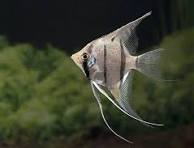1
/
of
1
Midwest Aquarium and Pond Supplier LLC
(189) Peruvian Altum Angelfish Large size
(189) Peruvian Altum Angelfish Large size
Regular price
$89.99 USD
Regular price
Sale price
$89.99 USD
Shipping calculated at checkout.
Quantity
Couldn't load pickup availability
The "Peru angelfish," often known by the trade name Peruvian Altum Angelfish or Rio Nanay Angelfish, is a naturally occurring regional variant of the common freshwater angelfish, Pterophyllum scalare. It is not a separate species from P. scalare, nor is it the true, more sensitive Pterophyllum altum from the Orinoco basin, though it shares a visual resemblance.
Key Characteristics
- Scientific Name: Pterophyllum scalare "Rio Nanay" (a locality variant).
- Origin: Native to the Rio Nanay river system, a blackwater tributary of the Amazon River in northern Peru.
- Physical Appearance: It has a tall, laterally compressed body with elongated fins. The base color is typically silver or pale gold with four vertical black stripes and characteristic small reddish or pink spots that become more prominent with age.
- Size: Can reach a height of 6 to 10 inches (15-25 cm) in the aquarium, including finnage.
- Habitat in the Wild: Found in warm, slow-moving, acidic, heavily tannin-stained blackwaters with plenty of submerged driftwood and leaf litter.
Aquarium Care
- Tank Requirements: A tall aquarium of at least 30-50 gallons is recommended to accommodate their body shape and swimming patterns. Provide plenty of plants (e.g., Amazon sword plants), driftwood, and hiding spots.
- Water Parameters: They prefer soft, slightly acidic water, ideally with a pH of 6.0-7.4 and a temperature range of 76-82°F (24-28°C). Wild-caught specimens may require stricter adherence to these parameters than captive-bred ones.
- Diet: They are omnivorous ambush predators. In the aquarium, they accept a varied diet of high-quality flakes or pellets, supplemented with frozen or live foods like bloodworms, brine shrimp, and daphnia.
- Behavior: Generally peaceful for cichlids, but they can be territorial, especially when breeding. They do best in groups of five or more to help disperse aggression.
The "Peruvian Altum" is a popular and striking choice for aquarists due to its elegant appearance and adaptability compared to the true P. altum species.
Share
No reviews

